The BFS Total ProgramThe origin of athletic training programs began in the late 1950’s with track athletes, specifically with the throwers. Shot put, discus, hammer and javelin throwers discovered that by lifting heavy wBy Dr. Greg Shepard Published: Spring 1996 Introduction The Upper Limit coach who desires a state-of-the-art program must be acutely aware of the importance of a total program concept for his athletes. You can no longer just emphasize lifting a few weights and work out a few months in the off-season. It is much more complicated than that. A state-of-the-art program must include not only a lifting program but also just the right balance of flexibility, speed, plyometric, agility and technique of sport(s) training. The origin of athletic training programs began in the late 1950’s with track athletes, specifically with the throwers. Shot put, discus, hammer and javelin throwers discovered that by lifting heavy weights their performance would improve. This improvement did not come by little bits, but came in huge chunks once the athlete caught on and ad access to “the secret”. By the late 1960’s many throwers weighed 265-plus pounds while running a 4.6 forty. In contrast, pro football linemen were much smaller, weaker and slower at this time. Shot put distances for the top twenty throwers increased by about ten feet and nearly twenty-five feet in the discus. To put it simply if you didn’t know “the secret” you couldn’t compete. As a football coach, I was fascinated by these huge, fast throwers. Since I had some friends who were world class throwers, I made it my business to learn “the secret”. I’d spend my springs in the late 1960’s in Los Angeles where the great throwers assembled. It was great fun to train on this program but even greater fun to bring it back to Sehome High School in Bellingham, Washington where I coached football and track. We were the only ones in the state, high school or college, who had access to “the secret”. Wow, what an advantage! We had fifty football players running 5.0 or faster in the forty. Many players weighed over 200 pounds while benching 300-plus, squatting 400-plus and dead-lifting 500-plus. Naturally, we wiped up in football. Sehome High School had an enrollment of 1400 in the top four grades and we played a number of schools with significantly greater enrollment. In a kind of mythical state championship post-season game, we clobbered Snohomish 27-7 and held them to minus rushing yards. In track, I had eleven discus throwers between 140 and 180 feet. That’s better than some entire states even today. During this time of the 1960’s and early 1970’s, athletes and coaches from other sports dabbled in strength training. Basketball and baseball shunned weights like the plague, while football coaches flitted about from one thing to another. It wasn’t so much of trying to “the secret” a secret but more of just not broadcasting your advantage to the world. Also it seemed that football coaches were looking for three things: something quick, something easy to administer and something safe. Since less than one percent of football coaches at that time had any self experience in weight training, they were, of course, terribly naïve and gullible. German “scientists” came out with astounding statistics on isometrics. They claimed that strength gains of 3% a week could be made by pushing or pulling against an immovable object. All you have to do was go hard for six seconds, repeated three times. It certainly was appealing: Quick, easy and no coaching experience needed or necessary. What a joke! It took football coaches about a year during this mid-sixties fiasco to figure out that isometrics were a real waste of time. During this isometric episode, the throwers remained with their free weight, heavy core lift approach while shaking their heads in disbelief that football coaches could do something that crazy. Exer-Genie At about the same time, the Exer-Genie came upon the scene. Thousands of coaches purchased these gadgets. Again a short amount of time was required for a workout, it was safe and any coach by reading one page of instruction could administer the program. Perfect? Well, yes, except for one thing. It didn’t work very well at all. The throwers kept shaking their heads. Universal Gym Later in the 60’s decade, the Universal Gym exploded upon the athletic world. The sales pitch went like this: It’s safe, your loose weights won’t get stolen, your kids just go around the circuit and it’s easy. Administrators really liked the sales part. I was praying that every school I coached against would buy a Universal gym for the tremendous advantage my kids would have. My prayers were profoundly answered. Every high school in America, including mine, bought one. My administrator thought it would be a good idea. We used it for some auxiliary work. I though “Pretty expensive auxiliaries. The stupid thing cost more than all my free weight equipment.” Probably the majority of high school athletes until the mid-seventies used a Universal Gym or a similar machine like a Marci for the primary training mode. As more and more high schools were becoming aware of “the secret”, they began to turn away from their machines. To appease the women coaches, many football coaches would say, “OK, how about if we give you our Universal Gym.” It may have seemed like a good idea at the time but it was a great disservice to women’s sports because they can’t reach their potential without also training with “the secret”. Many football coaches then decided to give their Universal Gym to the junior high schools. This too seemed like a good idea, but now we find that “the secret” should be started at the seventh grade level. The Universal Gym people were smart. They recognized their machine was shifting to an antique status and they began building free weight equipment towards the end of the 1970’s. Nautilus Football coaches were not prepared to deal with Arthur Jones and his Nautilus machines. We have never seen such advertising before or since the Nautilus machines arrived in the early 1970’s. Thirty-six and forty-eight pages of advertising were put into journals like Scholastic Coach. Arthur Jones paid for it, so under our American capitalistic rules, he was able to say anything to anything to promote his machines. Since the vast majority of coaches had little or no experience in weight training, the advertising claims were taken in as gospel. It took about ten years for the majority of coaches to figure out that these elaborate, expensive Nautilus machines were no way for an athlete to reach his potential. The throwers just laughed and again shook their heads. Their secret seemed safe. However, for the four reasons machines began to dwindle in popularity, until today machines are almost entirely used for auxiliary exercises. First, high schools couldn’t afford $5,000 per machine so they used free weights. At first, these coaches wished they could have a shiny blue machine, but then their kids began having some great results. If the difference between machines and free weights were not so dynamically obvious, machines would have snuffed our free weights entirely. Second, the advent of the strength coach played a significant role in doing things right. Before the strength coach, it was usually administrators or the football coach who made strength-training decisions. By the early 1980’s nearly all major colleges had a strength and conditioning coach. Boyd Epley of Nebraska, an ex-track athlete, started the National Strength and Conditioning Associations (NSCA) in the late 1970’s. Books and publications like the NCSA and BFS Journal were being published. As a result, a more knowledgeable strength and football coach emerged. No longer were vast majorities of coaches gullible. Machine people still get asked to speak at clinics because they pay for booth space, but recently it has become embarrassing. Football coaches will make jokes and speak out during a machine presentation. To stay in business, the machine people have softened their claims considerably. Some have also started pr |
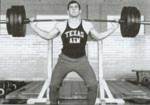 |
|
Randy Squatting in the 1960's. While at Texas A&M, he threw the shot over 70 feet |
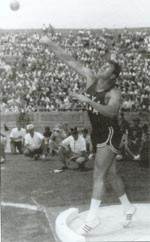 |
|
Shot Put World Record Holder (71-5/12) Randy Matson knew "the secret" om the 1960's |
|
|
|
Stefan Fernholm took "the secret" to another level. 6'1" 270 lbs. Squat 820, Power Clean 475, Power Snatch 350, V.J. 40", SLJ 11-3, Box Jump 58 1/2 |
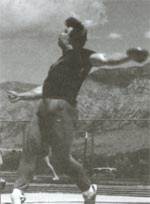 |
|
Stefan Fernholm, Ncaa Discus Record Holder and also had athe world's farthest throw for most of 1987 |
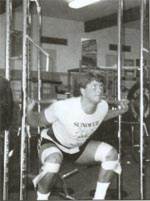 |
|
Brian Blutreich used "the secret" to produce the best double in high school history in 1986. Shot 69-1/2, Discus 210-8, Bench 405, Squats 515 Clean 320, Snatch 200, 40 yd 4.8, VJ 33" SLJ 10 |
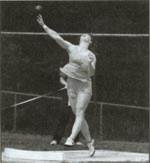 |
|
Christy Ward had the best Chot Put int eh nation in 1988 at 49 plus. Christy followed the BFS program exactly. She Benched 210, Squated 355, Power Cleaned 180, her VJ was 30 1/2" and 40 yard time was 5.13. |
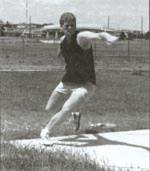 |
|
John Godina followed the BFS program exactly, and as a 16 year-old threw the Discus 194-8. He was also a Wyoming All-State Football Player and had a 4.0 G.P.A. John is now at U.C.L.A. and won the World Championship in 1995. |
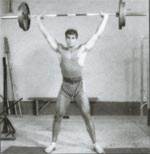 |
|
Kami Keshmiri, 6'4" 220 lbs., used "the secret" for the Nationa High School Record in the Discus in 1987. Kami Threw 225-2, Paralle Squat 530, Bench 395, Snathc 225, 40 yard 4.3, VJ 36", Shot 65-9 and a 3.5 G.P.A. |